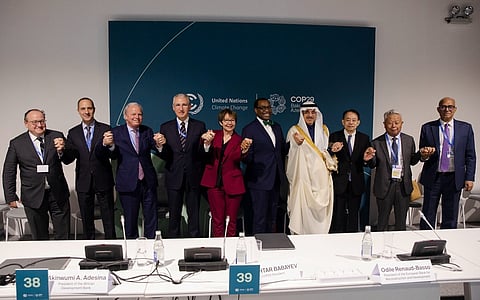

Emerging market and developing countries (EMDC) other than China require $2.3-2.5 trillion per year of investment in climate action by 2030, estimates a new report released at the 29th Conference of Parties to the United Nations Framework Convention on Climate Change.
Of the projected investment needs of around $2.4 trillion per year in 2030, around $1.6 trillion will be needed for the clean energy transition, $0.25 trillion for adaptation and resilience, $0.25 trillion for loss and damage, $0.3 trillion for natural capital and sustainable agriculture, and $0.04 trillion for a just transition. This is according to the third report of the Independent High-Level Expert Group on Climate Finance, launched by the COP26 and COP27 Presidencies to provide an independent perspective on the climate finance agenda.
The EMDCs, according to the report, will need the most investments for a global energy transition. These countries are the most vulnerable to climate impacts and are home to vast natural and biodiversity resources.
Of the 2.4 trillion, 1.4 trillion should be raised domestically, with $800-900 coming from public finance and $550-630 from private sources, requiring a growth of 2.7-3 and 5-7 times, respectively.
The remaining 1 trillion dollars can be raised through international means, with private finance, multinational development banks (MDBs like the World Bank), bilateral finance, south-south cooperation and other concessional finance of providing $450-550, $240-300, $80-100, $30-50, and $140-160, respectively.
The report comes as negotiators discuss the new climate finance goal, New Collective Quantified Goal for Climate Finance (NCQG) at COP29.
“With its overall external finance of $1 trillion per annum to EMDCs other than China by 2030, and its basic elements of private, multilateral development banks, bilateral and other concessional flows, this framework provides the key conceptual and practical set of numbers for climate finance, and can inform discussions about the NCQG,” reads the report.
At a press conference on November 14, Jacob Werksman, Principal Adviser for International Aspects of EU Climate Policy, European Commission said that the report has generated numbers to help guide policymakers on what is needed and achievable. This will help provide a little bit more framework to close the gap we are seeing during negotiations, he added.
By 2035, the overall figure for climate investment in EMDC, barring China, is projected to reach $3.1-3.5 trillion annually.
The report called for developed nations to triple their $100 billion commitment made at COP15 in 2009 for 2020 and extended through 2025. This commitment of providing $100 billion was only met in 2022.
It also urged stakeholders to provide ambitious commitments, including the MDBs, the private sector, and developing countries that can provide support. It noted that developing countries (‘South–South cooperation’) are already making a significant contribution and there is great scope for enhanced support and financing from leading developing countries. This expansion of donor contributors of climate finance is echoed by the EU, US, Japan, EIG bloc, Switzerland, Norway, Australia, United Kingdom and Canada, according to a position paper from the Centre for Science and Environment. At COP29, China announced that it had provided a climate finance of RMB 177 billion ($24.5 billion) to support other countries’ climate efforts since 2016, according to The Guardian.
The experts also recommended that taxing of high-emitting sectors internationally could potentially raise revenue that could be used to fill the concessional financing gap. Nearly 70 per cent of finance provided by developed countries are in the form of loans. Between 2016 and 2022, 79 per cent of loans extended by bilateral providers, 41 per cent and 23 per cent of loans by multilateral climate funds and MDBs respectively were concessional, according to the Organisation for Economic Co-operation and Development.
The report has also projected that the world needs an investment of around $6.3-6.7 trillion per year by 2030, of which $2.7-2.8 trillion will be in advanced economies and $1.3-$1.4 trillion in China. For 2035, the overall global investment estimates are $7-8.1 trillion per year, with advanced economies needing $2.6-3.1 trillion and China requiring $1.3-1.5 trillion.